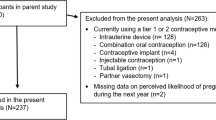Abstract
This research was designed to identify determinants of unintendedpregnancy among women attending family practice or family planning clinics.Survey data were collected from 95 women who were categorized according towhether or not they had experienced an unintended pregnancy. Women reportingunintended pregnancy were younger, reported earlier sexual debut and agreater number of sexual partners than those not having experienced anunintended pregnancy. Those who had avoided unintended pregnancy displayedhigher levels of preventive sexual self-efficacy, had more confidence intheir ability to use contraceptive methods, perceived more negativeconsequences associated with having children in the near future, andbelieved pregnancy among unmarried women to be less acceptable than didwomen who had had unintended pregnancies.
Similar content being viewed by others
References
Harlap D, Kost K, Forrest JD. Preventing Pregnancy, Protecting Health: A New Look at Birth Control in the United States. New York: The Alan Guttermacher Institute, 1991:19–39.
Forrest JD. Epidemiology of unintended pregnancy and contraceptive use. Am J Obstet Gynecol. 1994;170(5):1485–9.
Sulak PJ, Haney AF. Unwanted pregnancies: Understanding contraceptive use and benefits in adolescents and older women. Am J Obstet Gynecol. 1993;168(6):2042–8.
Williams LB. Determinants of unintended childbearing among ever-married women in the United States: 1973–1988. Fam Plann Perspect. 1991;23(5):212–21.
Sable MR, Stockbaver JW, Schramm WF, Lard GH. Differentiating the barriers to adequate prenatal care in Missouri, 1987–1988. Public Health Report. 1990;105(6):549–55.
Myrhman A. The Northern Finland cohort, 1966–82: A follow-up study of children unwanted at birth. In: David HP, Dytrych J, Matejcek J, Schuller V, eds. Born Unwanted. New York: Springer; 1988:103–10.
Pamuk ER, Mosher WD, NCHS. Health aspects of pregnancy and childbirth: United States, 1982. Hyattsville, Maryland: US Department of Health and Human Services, Public Health Service, CDC, 1988: DHHS publication no (PHS)88–1992. (Vital and health statistics; series 23, no. 16).
Balassone ML. Risk of contraceptive discontinuation among adolescents. Soc Adoles Med. 1989;10:527–33.
Voydanoff P, Donnelly BW. Adolescent sexuality and pregnancy. California: Sage Publications, 1990.
Rosenberg M. Society and the adolescent self image. New Jersey: University Press, 1965.
Donovan P. The politics of blame: Family planning, abortions and the poor. New York: The Alan Guttermacher Institute, 1994.
Kost K, Forrest JD. Intention status of US births in 1988: Differences by mothers' socioeconomic and demographic characteristics. Fam Plann Perspect. 1994;27(1):11–17.
Jessor R, Costa F, Jessor L, Donovan JE. Time of first intercourse: a prospective study. J Pers Soc Psychol. 1983;44:608–26.
Farley R, Allen WR. The color line and the quality of life in America. Committee for Research on the 1980 Census. New York: Oxford University Press, 1989.
Grady WR, Hayward MD, Billy JO, Florey FA. Contraceptive switching among currently married women in the United States. J Biosoc Sci. 1989;11(Supplement):117–32.
Brewster KL. Race differences in sexual activity among adolescent women: The role of neighborhood characteristics. Am Soc Rev. 1994;59:408–24.
Brewster KL, Billy JO, Grady WR. Social context and adolescent behavior: The impact of community on the transition to sexual activity. Soc Forces. 1993;71 (3):713–40.
Flessing A. Unintended pregnancies and the use of contraception: changes from 1984 to 1989. Br Med J. 1991;302:147.
Author information
Authors and Affiliations
Rights and permissions
About this article
Cite this article
Williams, S., Frank, M., Ilegbodu, A. et al. Factors associated with unintended pregnancy. Advances in Contraception 13, 429–438 (1997). https://doi.org/10.1023/A:1006557710997
Issue Date:
DOI: https://doi.org/10.1023/A:1006557710997




